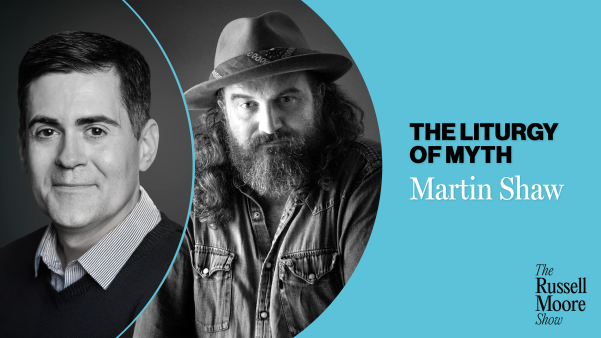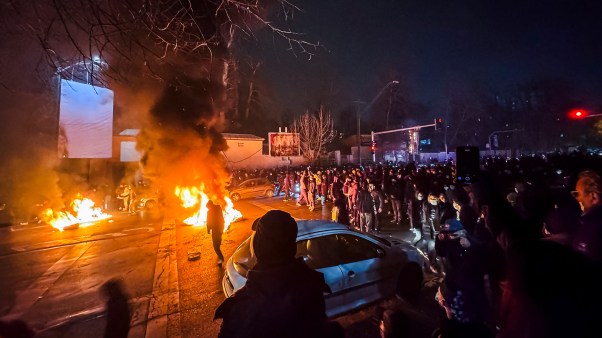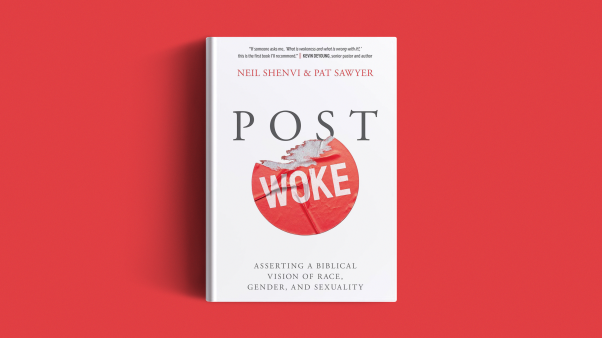The reactions to the spiritual awakening that began at Asbury are almost as fascinating as the event itself. By and large, the response has been one of awe and hope—as countless pastors and lay Christians, including myself, have flocked to Wilmore to get a sense of what’s in the air.
But there have also been numerous critical reactions from many corners of Christian culture that range across the ideological spectrum.
“Revival is more than singing and crying,” I’ve seen some say. “I’ll believe it’s revival when they denounce their toxic and abusive theology,” others have said. Frankly, you can name almost any topic and find someone tweeting or blogging about how the Asbury revival is or isn’t adequately addressing it.
Some say the gathering was too evangelical, not evangelical enough, too socially conscious, not socially conscious enough, too LGBT-affirming, not LGBT-affirming enough, and so forth.
Others have judged these events entirely through the lens of our political polarization—lumping Asbury students in with their complaints against white evangelicals at large and accusing them of being guilty by association. And although several charismatic figures aligned with Trump have endorsed the event, the student leaders, some of whom aren’t even white, have expressed no ties to them.
Such reactions have revealed the fault lines in evangelicalism today that, superficially, represent the anxieties and culture wars of the moment. At their roots, however, many of these criticisms point back to a more fundamental theological anxiety. In asking what should or shouldn’t be celebrated as a revival, we quickly find ourselves asking what is and isn’t the gospel.
As John Frame and Vern Poythress argued (and Tim Keller further developed), “the gospel” might refer to any one of three interrelated paradigms: the gospel as cross, focused on the atoning work of God through Jesus; the gospel as kingdom, focused on the new-making of all things; or the gospel as grace, focused on sinners’ adoption by God the Father.
Emphasizing one aspect of these over the others—as different streams within evangelicalism and the church more broadly have tended to do—has a powerful effect on the shape of ministry and the kind of language used to describe the gospel.
For instance, accentuating the gospel as cross can result in a greater awareness of sin and holiness (think John Stott). Highlighting the gospel as kingdom can lead to a stronger sense of duty around social and cultural transformation (think N. T. Wright). Underscoring gospel as grace can create a community of radical acceptance (think Brennan Manning).
Overemphasizing any one of these gospel perspectives over the others has liabilities as well. Leaning too heavily on the gospel as cross can make the gospel transactional: “I believe the right things, and God forgives me.” With this, you can lose sight of the gospel as gift, and doctrinal orthodoxy becomes determinative of who’s in and who’s out.
An overreliance on the gospel as kingdom can turn into its own kind of legalism, where anyone not devoted to a specific social cause is denying the faith. And if the gospel as grace is framed in a way that overshadows the other two approaches, we can lose sight of orthodoxy or find ourselves endorsing an antinomian spirit of let’s “go on sinning so that grace may increase” (Rom. 6:1).
These lenses can be helpful in thinking about the various reactions to the Asbury awakening.
Those with a gospel-as-cross mentality might feel anxious about whether sin and holiness are being sufficiently confronted or whether doctrinal orthodoxy is sufficiently policed. Those with a gospel-as-kingdom mindset might worry about how the Asbury revival reflects or impacts other relevant social issues plaguing the evangelical community today like racism, political authoritarianism, the crisis of leadership, and abuse in the church.
It seems to me that the gospel-as-grace folks are somewhat content with the recent events, and perhaps this adds one more reason for the other two groups to be critical.
Now, there are good-faith and bad-faith versions of all these critiques. It is always worth asking whether a revival is centered on Jesus and presents him as our only hope in life and death. And in the time I spent at the gathering myself, I found this was unabashedly clear.
Perhaps the most intriguing critique to me comes from disillusioned evangelicals—a community dear to my own heart as, in many ways, I count myself among them.
I’m a child of the ’80s and ’90s. I went to See You at the Pole prayer events, filled out a True Love Waits commitment-to-purity card, and participated in more high-intensity extended worship gatherings than I can count. I’ve even had a couple of encounters with third-wave charismatic events, witnessing everything from promises of healing to holy barking.
For better and worse, I’ve been to all the emotion-driven “mountaintop” experiences the evangelical world has had to offer.
These kinds of hyped events understandably have a bad rap these days, especially for those who are still reeling from the shock of abuse scandals and political power grabs. Thus, a certain amount of suspicion about such events is justifiable.
But skepticism is also unavoidable in our day, since we live in what philosopher Charles Taylor calls “cross-pressure”—the intersection of multiple accounts of belief and unbelief. While the struggle between faith and doubt is nothing new, the age we live in has amplified it by making doubts about the supernatural a default setting, meaning that our imaginations and instincts are inclined to doubt in ways that are uniquely modern.
For Christians whose faith is disrupted by pain or grief, that “disenchanted” narrative has an intensity that doesn’t just call our own experience into question; it calls into question the possibility of spiritual experience altogether. There’s a fine line between rightful discernment and undue cynicism—and for those of us clinging to faith on the other side of grief and loss, that distinction is critical.
Cross-pressure can also cause us to reinforce our views and protect ourselves against healthy challenges to our theological blind spots. By defining faith as right doctrine, right practice, or right politics, we reduce it to something manageable. We also erect borders that can clearly determine who’s “in” and who’s “out.”
But grace is an untamed thing, consistent only in its tendency to defy reason and laugh at our expectations. There’s a lavishness to it, whether it’s in God’s tendency to save the “greatest of sinners” or in the indiscriminate way Jesus dispensed miracles and mercy in his ministry.
Recognizing this fact doesn’t mean we should dismiss concerns about the doctrines inside the chapel and social action outside the chapel. The history of revival should remind us that both matter in the long-term “success” of any movement.
But it does mean we should have humility when grace shows up in ways we did not expect, as well as patience for the work of God that might follow it.
It’s also worth asking whether—like so much else in life—mountaintops in general ought to be viewed with suspicion. Or, to put it differently, what role do high-water events like those of the students gathered in Hughes Chapel have to play in the Christian life?
Some mountaintops are manufactured, and in time they crumble and disappoint. But not all of them are. The fact is that God seems to like these pinnacle experiences. He showed his glory in a sky full of stars to Abraham and in fire and smoke atop Mount Sinai. Jacob wrestled with the presence of God and was never the same again. Peter, James, and John saw Jesus in all of his glory at the Transfiguration. Paul was taken up into “the third heaven” (whatever that means).
Wisdom also pays attention to church history, where figures like Teresa of Avila had profound experiences of intimacy with God, or where John and Charles Wesley had religious awakenings in midlife while already serving and working in ministry.
There are times when God shows up in our lives in uniquely rich, powerful, and humbling ways. They are unpredictable and often fleeting, but they seem to be part of the way he works in the lives of believers. We ought to welcome them for ourselves and others, and we ought to resist responding to them with a wary pessimism.
Perhaps the most important thing we ought to offer those who’ve gathered inside Hughes Chapel is our attention.
When I was there, I saw that the leaders had made a deliberate decision to amplify only the voices of the students and leaders on the campus. Both well-meaning Christian celebrities and grifting hucksters were turned away. There were no lights, smoke, or lasers. There was lots of prayer, Scripture, and testimony. Contrary to the complaints of some on social media, many spoke of God’s holiness, our sinfulness, and Christ’s saving work on the cross.
There was no talk of culture war, no indulging of identitarian hostilities. Instead, the students were crying out to God for relief from depression, anxiety, suicidal thoughts, and addictions. They prayed for their lost friends and family members. They confessed their own sins and asked for holiness. The word “humility” came up again and again.
And this is where my own heart broke.
So much of life in the modern church is designed to compete with the noise and energy of the world around it: celebrity, production, hype, conspicuous consumption of Christian goods. At Asbury, I witnessed a community of young people who found what they were looking for in an entirely different place. They heard stories of a revival at Asbury in the decades before them, got on their knees, and asked God, “Do it again. Do it with our generation. Do it here.”
It reminded me of the best of my own mountaintop experiences, which didn’t take place at big concerts or well-planned retreats. Instead, they happened in ordinary or quiet places: an Ash Wednesday service, a living room, or a monastery basement. Like the folks I met at Asbury, I don’t have words to describe those experiences beyond saying that they changed me and left me with a deeper sense of God’s grace, presence, and kindness.
The administration at Asbury has chosen to return the campus to its regular rhythms. They’ve encouraged other churches and ministries to bring that spirit of awakening home with them, reviving their own communities with a renewed commitment to prayer and worship. The students will return to class, the giant screens on the lawn will be taken down, and the buses and RVs will leave.
My hope is that it will remain a milestone for those who gathered there and met Jesus through songs, prayers, and tears. I hope we’ll continue to see the fruit of revival—a renewed commitment to sharing the gospel, to loving our neighbors, to seeking justice for the poor and oppressed.
Maybe what some sneer at as the foolishness of youth is simply their earnestness. Maybe the inner voice that mocks their naiveté is the voice of the devil. Maybe we don’t know the stories of the young people in that room and what they have suffered.
And maybe we don’t know just how much our own mountaintop experiences have sustained our faith over the years—even on the other side of loss and grief.
As discouraging as the last decade has been, as wary as we may be from the church’s crises of leadership and abuse, Asbury ought to remind us that we can’t predict what God might do at any given time—and that revival is never foreclosed as a possibility for the church. I hope and pray that we all might have the spark of hope to remember our own past encounters with God’s grace and pray, “Lord, do it again. Do it here. Do it with me.”
Mike Cosper is the director of CT Media. He is the host of The Rise and Fall of Mars Hill and cohost of The Bulletin podcasts.









